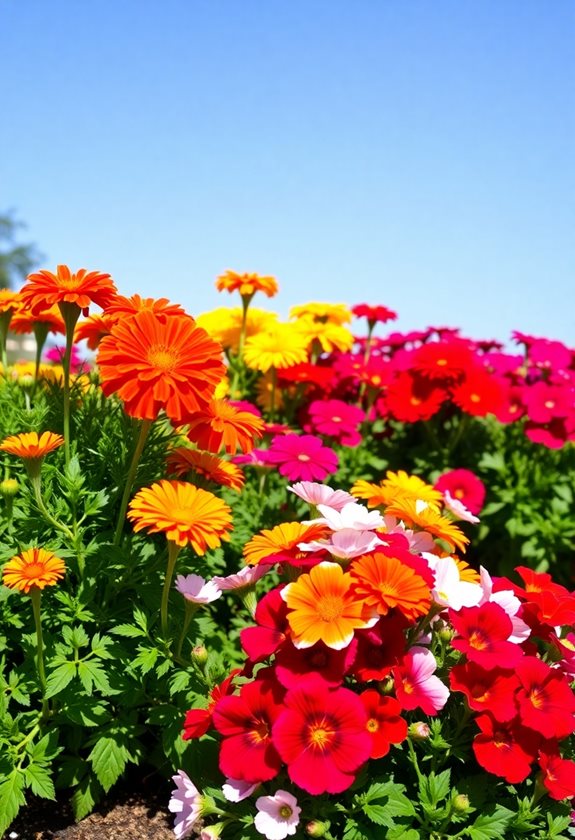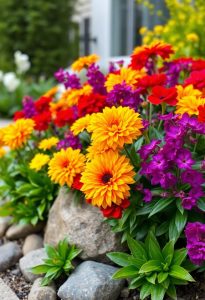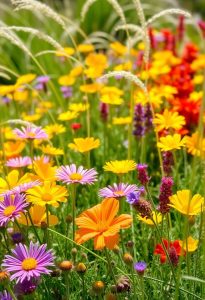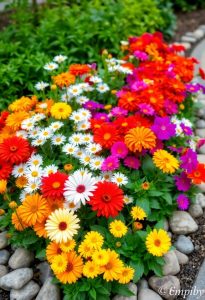If you want a colorful garden bed, why not try some simple flowering plants? Daisies bring cheer and attract butterflies, while marigolds shine brightly and help keep pests away. Zinnias are super easy and offer vibrant blooms. Don’t forget coneflowers and black-eyed Susans—they’re hardy and drought-resistant! Ah, and lavender can add a lovely fragrance! Plant a mix for a dynamic look, and you’ll be amazed at the buzz of life in your garden! Discover more plant options that will brighten your space!
Design Highlights
- Daisies are cheerful, easy to grow, and attract butterflies, making them perfect for colorful garden beds.
- Marigolds provide vibrant oranges and yellows, attracting pollinators while serving as natural pest control.
- Zinnias offer a dazzling array of colors and shapes, thriving in full sun and blooming from summer to frost.
- Coneflowers are hardy perennials that bloom in vibrant colors, are drought-resistant, and attract butterflies and bees.
- Black-eyed Susans are bold, easy to grow, and bloom all summer, adding vibrant color and attracting pollinators.
Daisies: The Cheerful Classic
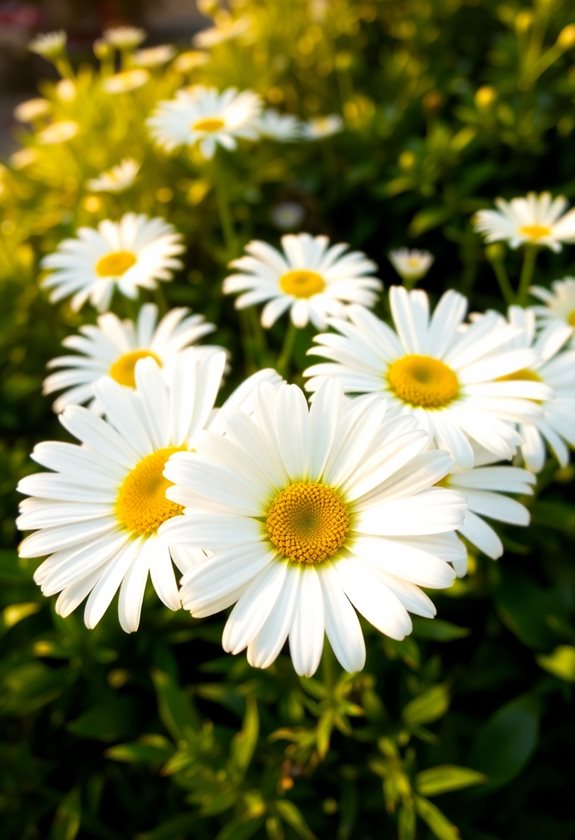
When you think of a garden bursting with color, isn’t it hard not to picture cheerful daisies swaying in the breeze? These iconic flowers aren’t just pretty; they’re resilient and easy to grow! Plant them in well-drained soil and watch as they thrive with minimal care. Daisies bloom from spring through summer, inviting butterflies that add even more life to your garden. Additionally, incorporating colorful flower beds can enhance the overall appeal and attract a wider variety of pollinators.
To maximize their beauty:
- Group them in clusters for an eye-catching effect.
- Mix with taller plants for dynamic layers.
Ever tried making a daisy chain? It’s a delightful way to connect with nature! So, get planting those cheerful classics!
Marigolds: Bright and Resilient

While daisies paint your garden with cheerful whites and yellows, marigolds step in with their vibrant oranges and yellows, ready to light up any space. These beauties aren’t just colorful; they’re incredibly resilient! Do you want to attract pollinators? Marigolds are a magnet for bees and butterflies. Plus, they’re great for pest control—who knew flowers could be so handy? When you plant them, make sure you give them full sun and well-drained soil. Water them regularly, but don’t drown them! Adding marigolds can also enhance your garden’s aesthetic appeal. So, why not add marigolds to your garden? They’ll bring joy and color, guaranteed!
Zinnias: Vibrant and Diverse
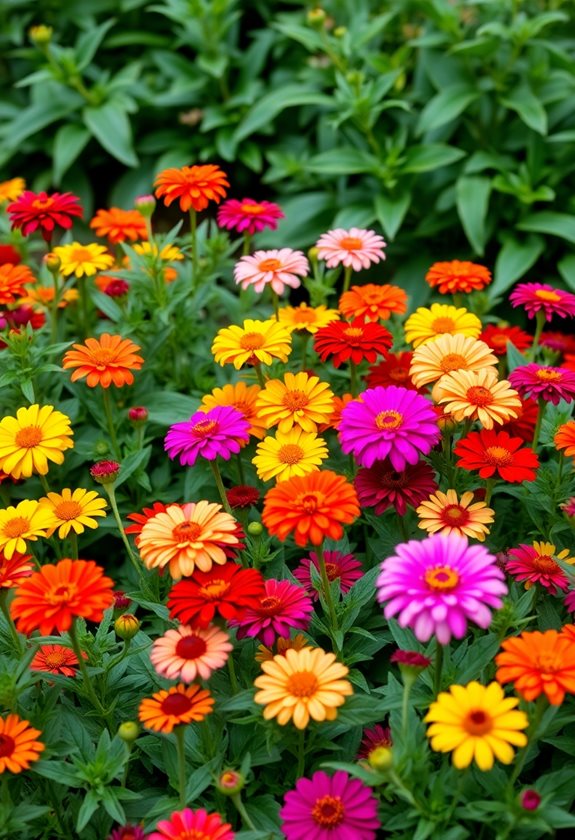
Zinnias, with their dazzling array of colors and shapes, are like the confetti of the garden world! You’ll love how easy they are to grow, bringing vibrant energy to your beds. These beauties thrive in full sun and bloom from summer to frost, making them a gardener’s best friend. Consider mixing different varieties—like the tall “Benary’s Giant” or the charming “Zahara” series—for a dynamic display. Plus, they attract butterflies! Just deadhead spent blooms to encourage more flowers. Isn’t it satisfying to see your garden come alive? Immerse yourself in zinnias, and let their colors spark joy in your backyard! Additionally, mastering flower arrangements can enhance your overall gardening experience by allowing you to create stunning displays with your blooms.
Coneflowers: Hardy and Beautiful
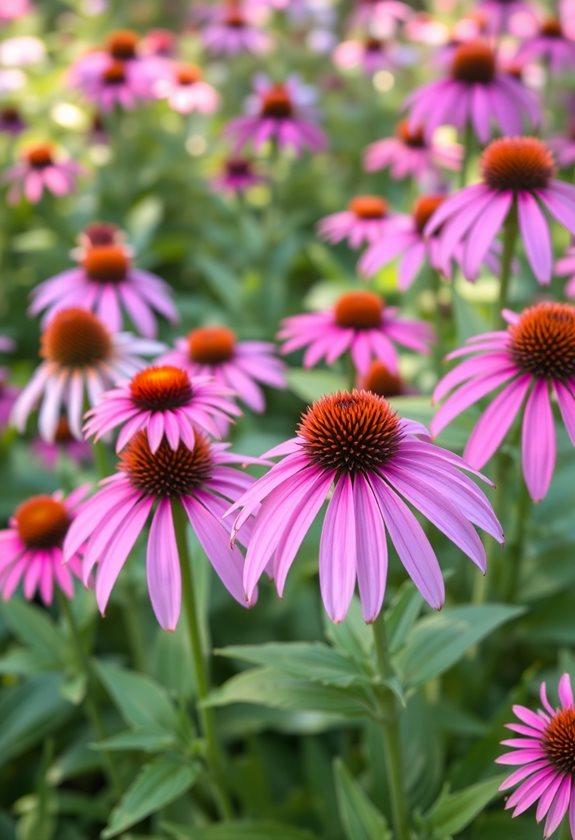
Coneflowers, or Echinacea, are like the dependable friends of your garden—hardy, beautiful, and always ready to brighten your day! These perennials thrive in various conditions, making them perfect for novice and experienced gardeners alike. Just imagine vibrant purple, pink, and white blooms dancing in the summer breeze!
Plant them in well-drained soil and sunny spots; they’ll reward you with long-lasting color. Plus, they’re drought-resistant, so you won’t have to worry too much about watering. Have you tried growing them? You might even attract butterflies and bees! With coneflowers, your garden will truly come alive! Additionally, they pair wonderfully with edible plants for a lush garden design that offers both beauty and flavor.
Black-eyed Susans: Bold and Easy

If you’re looking to inject some bold color into your garden beds, Black-eyed Susans are your go-to choice! These vibrant beauties not only brighten your space but are also incredibly easy to grow. Here’s why you’ll love them:
- They’re drought-tolerant, saving you time on watering.
- They attract butterflies, adding life to your garden.
- They thrive in various soil types—no need to stress!
- They’re perfect for sunny spots, bringing energy to your landscape.
- They bloom all summer long, keeping your garden lively.
Additionally, they make a great companion plant for fragrant colorful flowers that will enhance the overall appeal of your garden. Trust me, once you plant these, you’ll be hooked on their charm and resilience!
Snapdragons: Tall and Charming

While you might think of snapdragons as just another pretty face in the garden, these tall and charming flowers bring so much more to the table! With their vibrant spikes reaching up to three feet, they make excellent backdrops for shorter blooms. Plus, they thrive in cooler weather, making them perfect for spring and fall displays.
Did you know they come in various colors? Think pink, yellow, and even deep purple!
To plant them, guarantee well-drained soil and full sun. Water regularly, but avoid soggy roots. With a little care, snapdragons will steal the show in your garden! Additionally, they are a great choice for low-maintenance colorful flower beds, ensuring your garden remains vibrant with minimal effort.
Petunias: Colorful and Versatile
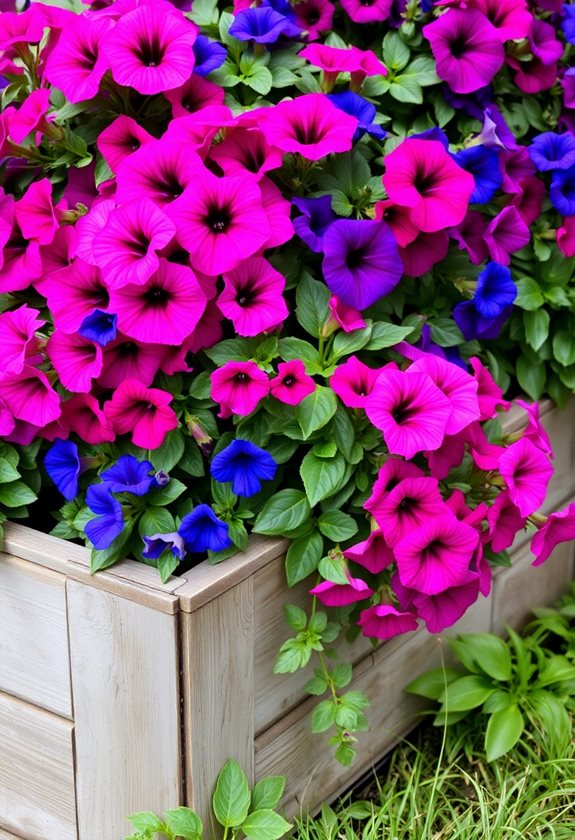
Petunias might just be the secret weapon your garden’s been missing! These vibrant beauties come in various colors and forms, making them the perfect addition to any garden bed. You’ll love their versatility! Here are a few reasons to take into account planting petunias:
- They bloom all summer long.
- They thrive in sunny spots.
- They’re available in trailing varieties, perfect for hanging baskets.
- They attract pollinators, adding life to your garden.
- They’re low-maintenance, giving you more time to enjoy your outdoor space! Additionally, petunias can be used to create vibrant flower bed designs, enhancing the aesthetic appeal of your garden.
Pansies: Delicate and Delightful

When you think of cheerful flowers that can brighten up your garden beds, pansies definitely come to mind! These delightful blooms aren’t just pretty; they’re tough, too. Pansies thrive in cooler weather, making them perfect for early spring or fall. Their vibrant colors—like deep purples, sunny yellows, and fiery reds—can create stunning contrasts in your garden.
To plant pansies, loosen the soil, space them about 6-8 inches apart, and water them well. Pansies are also considered year-round perennials that can add lasting beauty to your garden with proper care.
Why not mix colors for a playful effect? You’ll be amazed at how these delicate beauties transform your garden into a colorful oasis!
Lavender: Fragrant and Low Maintenance

There’s something truly magical about the scent of lavender wafting through your garden, isn’t there? This enchanting plant not only brings a delightful aroma but also requires minimal effort to thrive! If you’re ready to embrace lavender, here are five reasons why it’s a must-have:
Embrace the enchanting scent of lavender and transform your garden into a serene oasis with minimal effort!
- Low water needs: Perfect for those busy days.
- Pollinator-friendly: Attracts bees and butterflies.
- Versatile uses: Great for cooking, crafting, and relaxation.
- Drought-resistant: Survives in challenging conditions.
- Beautiful blooms: Adds vibrant color to your garden.
When you plant lavender, you’re inviting beauty and tranquility into your outdoor space. Additionally, lavender is considered one of the best pollinator-friendly foliage plants, making it a great addition for supporting local wildlife. What’s not to love?
Frequently Asked Questions
What Is the Best Time to Plant These Flowering Plants?
You’ll want to plant your flowering plants in spring, once the frost has passed. This is when the soil warms up and encourages growth. If you’re enthusiastic to get started, you can even begin indoors a few weeks earlier! Just imagine those vibrant blooms brightening your garden! Remember to check your local climate, though—some areas might have different timelines. Isn’t gardening just like a dance with nature? Timing makes all the difference!
How Do I Care for These Flowers Throughout the Seasons?
Caring for your flowers through the seasons can be a rewarding challenge! Start by watering regularly, but don’t drown them—think of it like giving them a drink, not a bath! In spring, fertilize to boost growth, and in summer, deadhead those blooms for more flowers. As fall arrives, trim back the foliage. And when winter comes, protect them with mulch. Isn’t it satisfying to see them thrive? Your garden will thank you!
Are These Plants Safe for Pets and Children?
You might be wondering, are these plants safe for your pets and kids? It’s essential to know before planting! Some flowering plants can be toxic. Always check species like foxglove or lilies. But don’t fret! Many vibrant options, like marigolds and pansies, are pet and kid-friendly. So, when you’re choosing, look for those safe beauties. Your garden can be colorful and safe—what a win! Keep your loved ones happy while you dig in!
What Soil Type Is Ideal for These Flowering Plants?
You’ll want well-draining soil for your flowering plants. A mix of loamy soil with organic matter, like compost, does wonders! It retains moisture but drains excess water, preventing root rot. Have you ever tried a soil test? It can help you understand your garden’s needs. Aim for a pH between 6.0 and 7.0 for ideal growth. Remember, happy roots mean happy flowers! So, let’s dig in and create that vibrant garden together!
Can These Flowers Attract Beneficial Insects to My Garden?
Did you know that about 75% of the world’s flowering plants depend on pollinators like bees and butterflies? When you plant those vibrant flowers, you’re not just beautifying your garden; you’re creating a haven for these beneficial insects! To attract them, consider adding daisies, sunflowers, or lavender. These blooms provide food and habitat, helping your garden thrive. So, why not cultivate a colorful space that buzzes with life? It’s a win-win!

